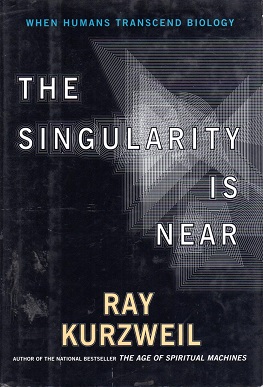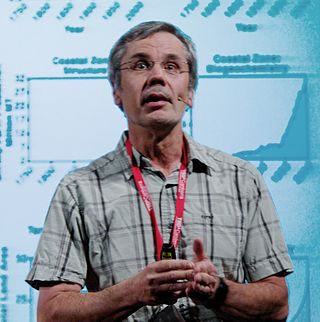The carrying capacity of an environment is the maximum population size of a biological species that can be sustained by that specific environment, given the food, habitat, water, and other resources available. The carrying capacity is defined as the environment's maximal load, which in population ecology corresponds to the population equilibrium, when the number of deaths in a population equals the number of births. The effect of carrying capacity on population dynamics is modelled with a logistic function. Carrying capacity is applied to the maximum population an environment can support in ecology, agriculture and fisheries. The term carrying capacity has been applied to a few different processes in the past before finally being applied to population limits in the 1950s. The notion of carrying capacity for humans is covered by the notion of sustainable population.
The technological singularity—or simply the singularity—is a hypothetical future point in time at which technological growth becomes uncontrollable and irreversible, resulting in unforeseeable consequences for human civilization. According to the most popular version of the singularity hypothesis, I. J. Good's intelligence explosion model, an upgradable intelligent agent will eventually enter a positive feedback loop of self-improvement cycles, each new and more intelligent generation appearing more and more rapidly, causing a rapid increase ("explosion") in intelligence which ultimately results in a powerful superintelligence that qualitatively far surpasses all human intelligence.

Future Shock is a 1970 book by American futurist Alvin Toffler, written together with his spouse Adelaide Farrell, in which the authors define the term "future shock" as a certain psychological state of individuals and entire societies. The shortest definition for the term in the book is a personal perception of "too much change in too short a period of time". The book, which became an international bestseller, has sold over 6 million copies and has been widely translated.
The Omega Point is a theorized future event in which the entirety of the universe spirals toward a final point of unification. The term was invented by the French Jesuit Catholic priest Pierre Teilhard de Chardin (1881–1955). Teilhard argued that the Omega Point resembles the Christian Logos, namely Christ, who draws all things into himself, who in the words of the Nicene Creed, is "God from God", "Light from Light", "True God from True God", and "through him all things were made". In the Book of Revelation, Christ describes himself three times as "the Alpha and the Omega, the beginning and the end". Several decades after Teilhard's death, the idea of the Omega Point was expanded upon in the writings of John David Garcia (1971), Paolo Soleri (1981), Frank Tipler (1994), and David Deutsch (1997).

The Anthropocene ( ) is the common name for a proposed geological epoch, dating from the commencement of significant human impact on Earth up to the present day. It affects Earth's geology, landscape, limnology, ecosystems and climate. The effects of human activities on Earth can be seen for example in biodiversity loss and climate change. Various start dates for the Anthropocene have been proposed, ranging from the beginning of the Neolithic Revolution, to as recently as the 1960s as a starting date.
Singularitarianism is a movement defined by the belief that a technological singularity—the creation of superintelligence—will likely happen in the medium future, and that deliberate action ought to be taken to ensure that the singularity benefits humans.

The Singularity Is Near: When Humans Transcend Biology is a 2005 non-fiction book about artificial intelligence and the future of humanity by inventor and futurist Ray Kurzweil.
In futures studies and the history of technology, accelerating change is the observed exponential nature of the rate of technological change in recent history, which may suggest faster and more profound change in the future and may or may not be accompanied by equally profound social and cultural change.
Global change in broad sense refers to planetary-scale changes in the Earth system. It is most commonly used to encompass the variety of changes connected to the rapid increase in human activities which started around mid-20th century, i.e., the Great Acceleration. While the concept stems from research on the climate change, it is used to adopt a more holistic view of the observed changes. Global change refers to the changes of the Earth system, treated in its entirety with interacting physicochemical and biological components as well as the impact human societies have on the components and vice versa. Therefore, the changes are studied through means of Earth system science.
The Early Anthropocene Hypothesis is a stance concerning the beginning of the Anthropocene first proposed by William Ruddiman in 2003. It posits that the Anthropocene, a proposed geological epoch coinciding with the most recent period in Earth's history when the activities of the human race first began to have a significant global impact on Earth's climate and ecosystems, did not begin during European colonization of the Americas, as numerous scholars posit, nor the eighteenth century with advent of coal-burning factories and power plants of the industrial era, as originally argued by Paul Crutzen, nor in the 1950s as claimed by the Anthropocene Working Group, but dates back to 8,000 years ago, triggered by intense farming activities after agriculture became widespread. It was at that time that atmospheric greenhouse gas concentrations stopped following the periodic pattern of rises and falls that had accurately characterized their past long-term behavior, a pattern that is explained by natural variations in Earth's orbit known as Milankovitch cycles.
John Robert McNeill is an American environmental historian, author, and professor at Georgetown University. He is best known for "pioneering the study of environmental history". In 2000 he published Something New Under the Sun: An Environmental History of the Twentieth-Century World, which argues that human activity during the 20th century led to environmental changes on an unprecedented scale, primarily due to the energy system built around fossil fuels.

Planetary boundaries are a framework to describe limits to the impacts of human activities on the Earth system. Beyond these limits, the environment may not be able to self-regulate anymore. This would mean the Earth system would leave the period of stability of the Holocene, in which human society developed. The framework is based on scientific evidence that human actions, especially those of industrialized societies since the Industrial Revolution, have become the main driver of global environmental change. According to the framework, "transgressing one or more planetary boundaries may be deleterious or even catastrophic due to the risk of crossing thresholds that will trigger non-linear, abrupt environmental change within continental-scale to planetary-scale systems."
Novel ecosystems are human-built, modified, or engineered niches of the Anthropocene. They exist in places that have been altered in structure and function by human agency. Novel ecosystems are part of the human environment and niche, they lack natural analogs, and they have extended an influence that has converted more than three-quarters of wild Earth. These anthropogenic biomes include technoecosystems that are fuelled by powerful energy sources including ecosystems populated with technodiversity, such as roads and unique combinations of soils called technosols. Vegetation associations on old buildings or along field boundary stone walls in old agricultural landscapes are examples of sites where research into novel ecosystem ecology is developing.

William Lee Steffen was an American-born Australian chemist. He was the executive director of the Australian National University (ANU) Climate Change Institute and a member of the Australian Climate Commission until its dissolution in September 2013. From 1998 to 2004, he was the executive director of the International Geosphere-Biosphere Programme, a coordinating body of national environmental change organisations based in Stockholm. Steffen was one of the founding climate councillors of the Climate Council, with whom he frequently co-authored reports, and spoke in the media on issues relating to climate change and renewable energy.
Future Earth is an international research program which aims to build knowledge about the environmental and human aspects of Global change, and to find solutions for sustainable development. It aims to increase the impact of scientific research on sustainable development.
Sybil P. Seitzinger is an oceanographer and climate scientist at the Pacific Institute for Climate Solutions. She is known for her research into climate change and elemental cycling, especially nitrogen biogeochemistry.
The Anthropocene Working Group (AWG) is an interdisciplinary research group dedicated to the study of the Anthropocene as a geological time unit. It was established in 2009 as part of the Subcommission on Quaternary Stratigraphy (SQS), a constituent body of the International Commission on Stratigraphy (ICS). As of 2021, the research group features 37 members, with the physical geographer Simon Turner as Secretary and the geologist Colin Neil Waters as chair of the group. The late Nobel Prize-winning Paul Crutzen, who popularized the word 'Anthropocene' in 2000, had also been a member of the group until he died on January 28, 2021. The main goal of the AWG is providing scientific evidence robust enough for the Anthropocene to be formally ratified by the International Union of Geological Sciences (IUGS) as an epoch within the Geologic time scale.
The term collapsology is a neologism used to designate the transdisciplinary study of the risks of collapse of industrial civilization. It is concerned with the general collapse of societies induced by climate change, as well as "scarcity of resources, vast extinctions, and natural disasters." Although the concept of civilizational or societal collapse had already existed for many years, collapsology focuses its attention on contemporary, industrial, and globalized societies.

Ecological overshoot is the phenomenon which occurs when the demands made on a natural ecosystem exceed its regenerative capacity. Global ecological overshoot occurs when the demands made by humanity exceed what the biosphere of Earth can provide through its capacity for renewal.
GEOINT Singularity describes a hypothetical future time when capabilities of geospatial intelligence (GEOINT) have advanced to full information availability and transparency. Physical activity on the earth's surface would then be monitored, analyzed and made available in real time and the information would be used by government, business, and individuals for decision making.







